The blessings of South Valley living
| Angela
Young's home page |
Contact Angela Young |
| Angela
Young's home page |
Contact Angela Young |
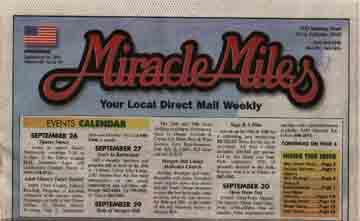
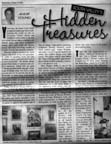 |
 |
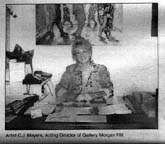 Artist C. J. Myers, Acting Director of Gallery Morgan Hill |
However, when it comes to the South Valley, folks think of our rich agricultural yields of vegetables, fruits, and nuts. But there is also a yield here that most of us have overlooked--the artistic variety grown from hearts of passion and creative expression. Along with our great California pioneers from long ago, a multitude of people came who have a fondness not only for the land but also for art. Remember, in those days, most people didn't own cameras, so artists were commissioned to draw or paint portraits of significant people or events in society. Any museum shows evidence of this.
Today, downtown Morgan Hill has a colony of artists that show their work at Gallery Morgan Hill. The gallery's 10th anniversary is coming up on November 10th 2001. There will be a reception for the artists and former members of the gallery, with refreshments on hand. This reception is open to the public and is free of charge. High quality paintings, sculptures, jewelry, ceramics, woodwork, painted eggs, unique furniture, and pottery are all originals made by the artists. The exhibits change every eight weeks. The gallery will be open during the "Taste of Morgan Hill" gala for folks to check out their amazing stuff. It's a fun place to visit.
Mary Hughes Hiller is one of the local artists featured at Gallery Morgan Hill, and her paintings in oil, watercolor, and oil pastels are currently on display. She had a three-week show in Mainz, Germany, before joining this gallery in 1995. Mary has a passion for fine art, and she loves to share her enthusiasm for it with others. Some of her impressive works depict rural life near Chesbro Reservoir and the eastern United States.
Acting director of the gallery is C.J. Meyers, with her lovely work in oil pastels also being exhibited. Many would agree that she does a superb job of portraying children, animals, and landscapes. She, along with other artists, is available to talk with visitors on a rotating basis.
In Gilroy, a spunky, passionate artist named Shirley McGee not only does art, but makes sure that others in her community could do the same. She is president of Theater Angels Art League (TAAL) and “It’s Time”... for the arts, which are both nonprofit organizations. Shirley and other members of these organizations are working hard to raise funds for a cultural arts center in Gilroy. For example, Theater Angels Art League has, for three years now, put on the Reek Run, which is a 5- and 10-kilometer race every July. They also support the Gilroy Garlic Festival, where volunteers work in Gourmet Alley and also sell wine in a booth there as well. “It’s Time” ... for the arts hosted the Festival of The Arts last February and recently sponsored a golf tournament for which they received $8,000; their successful Nunsense dinner theater production sold out three weeks in advance. They are currently planning another fundraiser, Casino Night, for October 13th 2001. For tickets, call 408-846-9191.
Downtown Hollister’s Jerome Grimmer Galleries has brought Yosemite's grandeur close for all to enjoy. How did they do it? Why, Jerome Grimmer painted the gorgeous landscapes in vivid acrylic colors and lit them with a unique style that is a trademark of his. A favorite painting of mine is his “Backlight,” a rural barn in brilliant light, which he created with his own impeccable charm. The gallery also features the original works of Hollister artists on a revolving monthly basis. Jerome Grimmer Galleries is open Tuesday through Friday from 12pm to 5pm and on Saturday, 11am to 5pm. For information about Mr. Grimmer’s paintings and upcoming events please call 831-637-8490.
 |
 |
 Looking North on Monterey street |
 The interior of the Gilroy museum |
 The old city hall building on Monterey street |
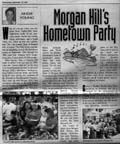 |
 |
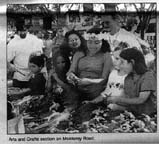 Arts and crafts along Monterey Road |
 Food booths at The Taste of Morgan Hill |
What do you get when you mix great food, mighty-fine wine, impressive works-of-art, awesome music, family fun events, happy merchants, and a south valley city rolled up into one celebration? The 12th Annual Taste of Morgan Hill, of course! The folks in the community are preparing to rock the downtown streets on September 29th through the 30th. Last year, Morgan Hill’s hometown party hosted about 40,000 people.
When did the Taste of Morgan Hill made its debut? Let’s go back to 1989, when the “powers that be” at the time were brainstorming on how to promote Morgan Hill’s downtown businesses. Greg Sellers, Lorraine Welk, and David Bischoff were among the members of the Downtown Revitalization Program. They came up with Morgan Hill’s first downtown shin-dig, to be held during the last Sunday in September. The inaugural event took place on Monterey Road, between Main and Third streets, on Sunday afternoon in front of merchants’ shops. They had food, drinks, music, and games. The city and citizenry worked together to make Taste of Morgan Hill a success. Four thousand people showed up for that one.
Twelve years later, the event has grown into a two day fling, and it's still free. The Morgan Hill Chamber of Commerce has been given the responsibility for the event since the early ‘90’s; member Mitch Mariani is coordinating it this year. The response from Bay Area artists has been overwhelming; the chamber couldn't accept any more applications, since the arts and crafts section has been full early-on.
The works of artists from Morgan Hill, Gilroy, San Martin, Hollister, San Juan Bautista, San Jose, Boulder Creek, and other parts of the Bay Area will be seen at the street fair. Flavia Enterprises from Boulder Creek will be selling multicolored vases that are to die for! I saw the gorgeous hand-crafted glass pieces in a photo it blew me away. Brilliant reds and blues with floral designs in a Japanese motif would please anyone, even hardened art dealers.
Gilroy's Heather Bruhn does Faux paintings on furniture that are a delight for the adventurous at heart. She restores used furniture and creates works-of-art out of them. If animal prints are your thing, then I recommend checking out this booth at the two day celebration.
The incredibly detailed artwork from Morgan Hill’s St. John The Divine Episcopal Church stood out to me. Their lovely Ukrainian Easter eggs (Pysanky) are sure to be best sellers at The Taste of Morgan Hill. I think they're classy, with each egg having a distinct personality. The artists use batik, which is a wax-resistant process, and it certainly looks as if they have a great deal of patience to do this kind of work. I admire the beauty and labor that has gone into each egg. To get a better idea about this form of art, go to the Morgan Hill Library on Peak Avenue and take a peek at the Pysanky Art in the glass booth near the entrance.
Let’s not forget the delicious food. I hear the barbecue guys from Hollister, Mansmith, will be back again. They always do a bang-up job with their mouth-watering meats. Also, Morgan Hill’s Rosy’s at the Beach restaurant will be serving their popular Cajun turkey legs, Salmon tacos, and barbecue corn. For those of you who prefer other types of cuisine to whet the palate, the other diverse eateries on Monterey Road will also have their doors open to the public.
The John Garcia Blues Band, The Dadz, and The Usual Suspects plan to shake the asphalt on Monterey Road on the main festival stage on West Third. Expect to see a jubilant crowd dancing to the lively tunes by Just Cuz near East First Street on the festival stage.
Whether you're attending the showcase event for the first time or 12th time, it all boils down to one thing: The Taste of Morgan Hill is one big, classy festival where neighbors can hang out, catch up on the latest stuff, and show off their beloved downtown to the throngs of humanity that are blessed to partake of it.
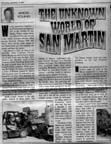 |
 |
 Forklift loading pavers
|
 Photo of San Martin Air Museum |
Waving farewell to Hollister, I head back north on Highway 101 to the vicinity of San Martin. What's unique about San Martin? For one, it's not a city, which becomes obvious when driving between Morgan Hill and Gilroy. Don’t let the small stature of San Martin fool you; the residents are spunky and have big hearts.
San Martin’s origins go back to the mid-1800s, when California Pioneer Martin Murphy Sr. and his family owned lots of land in the area. In April 1853, Martin’s son, Bernard, went to San Francisco, on the Steamboat Jenny Lind. He died on board when the 61 ton side wheeler’s boiler exploded. While grieving, Mr. Murphy Sr., built a small chapel in honor of Bernard, dubbed St. Martin after his patron saint. He dedicated it and buried his son there. Fire destroyed the little chapel in 1877, and the surrounding village adopted its name.
Acres of golden fields, lined with sprawling ranch style dwellings, create a postcard view of the town. You won’t find any tract housing there. Almost 2,000 people live in the community--homes surrounded by agriculture and stables.
South County Airport is the only public airstrip in these parts. The “Wings of History: California's Antique Aircraft Museum” is a treat for visitors of all ages. The Talbots provide free, excellent tours; they enjoy explaining the history of aviators gone by. When we went there recently, we entered a thrilling world of airplanes and their pilots’ passion for flying.
I saw engineering marvels made by folks who devoted their lives to soaring the friendly skies. One particular display stood out; it looked like a VW bug with a rotary blade attached to the top. I got a kick out of it. The brave guy who designed it truly believed in the impossible. I remember reading that it flew off 5 feet off the ground in its maiden voyage. I think the helicopter-car thing ended its illustrious career after that. Too bad. I thought it was pretty cool. For tours, please call (408) 683-2290 or visit them online at www.wingsofhistory.org.
Residents of San Martin are familiar with the natural stone and landscape material supplier Peninsula Building Materials (PBM) on Llagas Road since 1989. The Morey Family owns two other facilities on the San Francisco Peninsula. Marty Morey, third generation of the owners, came to work in San Martin temporarily in June and loved it. “San Martin reminds me of all the little towns that made up the peninsula and South Bay 30 to 40 years ago. All those towns became (large) cities. San Martin is still a community. People know one another..., “Marty said wistfully. He works at the Redwood City facility but misses the small town atmosphere of San Martin. Meanwhile PBM’s employees in the rural town, get to enjoy the lovely countryside all-year-round. Rick Lynch, Carmen Santoya, Mike Lima, and others plan to stay for good.
Carmen is glad for the easy commute and said, “I hated working in the city (San Jose). Bad traffic. It took an hour to drive to work each way. I'm comfortable here (In San Martin) and wouldn't leave.” Rick hires students from Live Oak high school during the summer months and trains them for the working world. The San Martin group also contribute to the community by sponsoring local sports programs.
The most impressive landmarks in San Martin are the gateway signs. Over a year ago, CordeValle Golf Course approached the San Martin Planning Advisory Committee about developing a golf course and 40 luxury homes in the region. When they asked what they could do for San Martin, the committee mentioned gateway signs to the entrances--one on San Martin Avenue near Murphy and the other two on the northern and southern ends of Monterey Highway.
The planning committee couldn't use the original wooden design, so they hired artists Phil Vanderkraats and Dick Shulte of “Signs by Van,” in Salinas, to create a new one. These artists carved the intricate artwork (the mold) out of high density foam, then contacted “Dave Chesney Studios” in Yuba City to pour bronze into the mold. However, Dave came up with the brilliant idea of using four different alloys instead of one: aluminum for the words San Martin; bronze for the horses, winepress, bottles, and grape basket; brass for the grape leaves; and copper for the grapes. Frames were then needed to support each 175 pound casting. Phil built three wooden structures to do the job. Because each frame weighs 400 pounds, it took several men to lift just one.
Countless hours of hard labor to transport, assemble, and install the signs by Bob Cerruti, Kitty Terry, and others went unnoticed by most people. You have to get close to one of these signs and touch it, to appreciate what these guys did for San Martin.
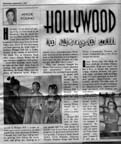 |
 |
 |
 |
How many of you dream of making it big in Hollywood or on Broadway? But the desire fizzles as reality reminds you that Tinsel Town and New York are hundreds of miles away from the South Valley area. Don’t let that discourage you from pursuing the bright lights of stardom; Morgan Hill has a hidden treasure in the middle of downtown! The Music Tree on Monterey Road offers classes (Drama Works) for all ages who caught the “acting bug.”
Arceli Bell, dramatic coach, teaches folks to face their worst fears in dealing with public performances. She knows the South Valley area has plenty of theatrical talent. When I moved to Morgan Hill a couple of years ago it never occurred to me that most people here did drama. I thought they were busy riding horses, growing corn, hiking the scenic trails, and going line dancing in a country music club somewhere. I honestly believed all the dramatic courses were in San Francisco or Los Angeles. Such were the silly thoughts of a big city girl who didn't have a clue!
“They (the parents) thought the Music Tree was just a music store that sold instruments,” Arceli said. Obviously the word isn't out as another parent told her a few months ago, “I never knew you had drama classes in Morgan Hill. I thought they were all in San Jose or San Francisco.” She's been hosting Drama Works for a year now. A good thing too. Morgan Hill is in the process of building a community theater and I'm sure plenty of people want to learn how to audition properly for plays and increase their acting skills. I'm one of them. South Valley Civic Theater, Odyssey Theater, Western Stage and South Valley Community Theater, and Teatro Campesino are a few of the venues for actors.
Drama Works help kids bring out their creativity in acting, singing, and music. Right now Arceli, who has a B.A. in theater arts, instructs young children between 3-6 years with songs, and basic skills in acting. Kids 7-9 years participate in fun theater games, improvisation, pantomime, and skits. The older ones, 10 and up learn more complex techniques on characterization, improvisation, stage movement, cold readings, and monologues.
For warm-ups in the more advanced drama workshop, Arceli told us to slap our faces and afterwards repeat, “Big black bug” five times to loosen our tongues. I mastered the tongue twisters until we recited “Peter Piper picked peppers.” I doubt if I still got it straight. The younger students like Katie, Chad, Deeanna, and Priscilla put me to shame. Following the theater games, some of us read scenes out of “Alice in Wonderland” to prepare for cold readings in auditions. It was fun, enlightening, and practical for all levels of actors.
This is not just for kids. Arceli created a new class for us “mature” human beings starting in September on Tuesday nights at 6pm. The adult group will focus on improvisation based on the popular television show “What’s My Line?”. Improv is more creative and fluid than reading out of a script. It forces the person to make things up as they go, giving maximum freedom in expression. I love it! In the future, Arceli wants to do Improv with her advanced students in the local eateries around town. Morgan Hill would benefit from something like dinner theater. It would be great if the other cities in the South Valley would do the same.
To get on board; call Arceli Bell at (408) 782-8644 or the Music Tree (408) 779-4312 for information on fees and schedules. I understand the classes are ongoing and you can take them anytime.
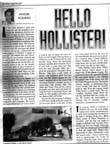 |
 |
 |
 San Benito street in downtown Hollister |
 Inside Di Britos chocolates |
All who enter Hollister’s gates will notice not only the gorgeous countryside but something else that captures the heart of most Americans: Chocolate! The De Brito Chocolate Factory is right off Highway 25 and sells one of the best samples of sweetmeat that exists in our Golden State. The beloved confectionery is open 6 days a week and does give tours but you must call ahead of time to set up one. I discovered this hidden treasure of Hollister a couple of years ago. My husband Ken and I decided to stop by one Saturday morning and we were hooked! The myriad of gourmet chocolates piled on the sample plate, the aromatic scents in the air, the friendly service, and gobs of tasty inventory in beautiful packaging will transport anyone into the Promised Land! Okay, so I got carried away a bit. You would too, if you ate one of their chocolates.
The De Brito Chocolate Factory is a success story about Alene De Brito who made the homemade candy in her own home in the days when her husband worked the farm near their present location. Her husband, Arnold, ran a farming implement business in Hollister and during the holidays his wife would be in kitchen batching up a tasty assortment of chocolaty delights for his friends, employees, and customers. Her chocolate dipped dried Apricots were extremely popular and of course the need for them exceeded supply. This put Alene in a dilemma; so the De Britos did the only sensible thing about the increasing demands and thus their chocolate factory was born. A good thing too! Ken loves the dark chocolate toffee and I adore the scrumptious Chocolate Cherry Flambe. They have a wide variety of fancies with California dried fruit and fresh nuts that would catapult the customer's taste buds above the clouds! The Chocolate Factory's customer service is impeccable with friendly folks like Alene and Vickie. They put the country hospitality into their store and make visiting their store so much fun. To get your hands on their quality confections; contact them at (831)-637-0164.
Now for the historical part; it all began in 1870 when Southern Pacific wanted to put in a train station in the area. At first they were turned down by the town of San Juan Bautista and went east to search for a location there. Colonel Hollister offered Southern Pacific to lay their tracks down onto his ranch and the result is this lovely city that we enjoy today.
Today Hollister holds about 30,000 human beings which makes it the largest city in San Benito County. The population enjoys the agreeable climate all year round thanks to the Gabilan Mountains west of the county seat and the Diablo Range to the east. During the summer months; an interesting thing occurs around 2pm when the weather patterns shift from the typical South Valley broil to a cooler trend. The surrounding mountain ranges block the tule fog and heat from the central valley. No wonder the municipality is thriving with 47 churches, multiple businesses, restaurants, and homes.
The housing market is booming in Hollister and over the years people hauled their family and possessions to settle down amongst the farmlands of the area. A resident of the city--Barry Olsen, owner of Paseo Properties in Campbell, told me that real estate is cheaper in Hollister than San Jose. Don’t let that you fool you, though. Barry also said, “But they (housing prices) are higher than one might think. Homes have appreciated in price substantially in the last several years.” Newer homes were built to accommodate the exodus of humanity from the larger urban sprawls within a decade and more are on the rise. However, the issue of the sewage treatment ponds on the outskirts are slowing this boom down, according to Barry. Heavy rains raised the water table during the wet season; the land wasn't able to absorb that much water and thus crippled the sewage ponds. Crippled sewage treatment ponds means restrictions on building permits which equals a crunch in zoning off land for future homes.
There's a joke circulating in Hollister between the locals, “When people move to Hollister they join the ‘No Growth Committee,’” Barry said with amusement. How true! I joined such a committee when I moved to Morgan Hill!
Hollister is also known for its agriculture; these come in a variety of colors and shapes as anyone visiting the surrounding lush fields will note. San Benito County's cash yields of lettuce, nuts, bell peppers, onions, garlic, broccoli, fruit orchards, and the like are a trademark of the fertile soil of the area. Many farmers in Hollister cultivate their crops organically which means they don’t use pesticides to ward off agricultural pests. Because of this type of agronomy, you'll find the organic label on numerous produce in health food stores in the Bay Area. In the 1870’s hay was a major export and brought prosperity to Hollister which was known as “Hay City” back then. Today the local high school is named the Balers in honor of the multitude of bales of hay that propelled their beloved city to fame from days of old.
What other kind of work is there besides pitching bales of hay and growing lettuce on the homestead? Corbin Pacific, maker of motorcycles and Sparrow electric cars, invites folks to check out their factory. You can see their cute, colorful transports parked outside Wizard's Cafe located at 2360 Technology Parkway in Hollister. For tours please call 831-635-1033. Two shopping centers brought more business into the community since 1990 and the wonderful restaurants sprinkled throughout the city limits continue to bless the palates with culinary masterpieces. Super Tacqueria never ceases to make my tummy happy with their delicious Mexican food, low prices, and fast service. I particularly like Mountain Mike's Pizza on Tres Pinos Road where they serve mouth-watering Pepperoni & Cheese pizzas and they bake theirs to a golden perfection adorned with crunchy pepperoni. My favorite! I can eat there all day!
Hollister boasts of fine restaurants like the Vault in downtown and the Elegant Touch where they serve sandwiches, salads, and pastries. There's so much more for the citizenry to chow down and the Chamber of Commerce is an excellent source for a list of eateries. An other source of income for Hollister is its other confectionery Marich on Bert Drive. These guys cook up candied delights such as caramels, malt balls, Wallabeans (real fruit jellies), chocolate covered nuts, dried fruits, and cookies. Marich does have a retail store on site and offer tours but you must call them first at 1-(800) 624-7055.
After munching on delicious candy that'll give anyone energy to partake in Hollister’s outdoor activities. How about skydiving? The rush of air in the face as one views the checkered landscape below from a parachute is thrilling. The Hollister Airport will gladly take you up in the beautiful blue skies for air gliding and skydiving. They can be reached at (831)-636-3799. If you're prone to keeping your feet glued to the earth then about hiking at the Pinnacles National Monument? Lovely trails, scenic volcanic formations, rocky crags, intriguing caves, refreshing forest await the visitor. The ever so prominent San Andreas Fault forged this park many years ago and so we are able to enjoy its splendors. Wildlife abound at the Pinnacles so don’t be surprised if you see furry critters roaming the more secluded areas. I've seen wild turkeys, bats, snakes, tarantulas, deer, rodents, all kinds of birds and bugs. The geology is rugged and an awesome challenge for mountain climbers. Running on the dirt trails in the wilderness goes into the celestial as far as I'm concerned. There's nothing like the radical experience of sprinting on air through the gorgeous scenery at the Pinnacles! Woo Hoo!
Hollister Hills presents off road fun for the entire family. They encourage folks to bring out their four wheel vehicles and dirt bikes to blaze the pathways. Those of you who like a more laid back approach to life, the many boutiques and shops in Hollister are there for you to enjoy. I discovered a treasure recently in downtown named the Grimmer Galleries that featured the works of Jerome Grimmer. The artist captures the heart with vivid images of rural settings on canvass using acrylic paint instead of oils. My favorite of his is “Backlight” which depicts an old barn's interior bathed in the golden sunlight. Milo, owner of the gallery, added dimension to the whole experience by sharing insight into Mr. Grimmer and the art world of Hollister in general. His friendly personality and willingness to talk with the patrons make it worthwhile to visit.
Every year motorcycle enthusiasts from all over converge to meet in downtown for The Hollister Independence Rally held the first week of July. This tradition started from a group of bikers who came to Hollister after World War II and stopped for a couple of days to race each other around town and trade adventurous stories. A guy named Frank Rooney wrote a story about the nomadic bikers. Later Hollywood picked up Frank's idea and turned it into a movie called “The Wild One,” which starred Marlon Brando. Now, roughly 60 thousand show up in town with their beloved bikes, showing off the latest in motorcycle technology or favorites from the past.
The San Benito County Fair in Bolado Park will be on September 27th-30th. Adults pay $5, senior citizens and children 6-12 years pay $3; kids 5 and under go in free. They also sell 4 day season passes for folks at a slightly higher fee which is a bargain. You don’t want to miss this event. For more information contact the fair office: (831) 628-3421.
Before setting foot in Hollister, I remember reading about it being the “Earthquake Capital of the World,” when I was a teen. The citizenry knows Hollister sits on top of the San Andreas Fault (California's largest earthquake fault) and is also close to the Calaveras Fault. Most shakers underneath the streets go unnoticed except by scientific instruments that record earthquakes called seismographs. When one does jolt our attention then the papers write about it and again we are reminded of Hollister’s seismic status. That's what first attracted me to the city; it had a sense of mystery about such things. Scientists from the U.S. Geological Survey in Menlo Park would take geology students on field trips to the city streets to witness seismology (earthquake science) at work. I loved going on these excursions. The San Andreas creeps about a centimeter or two a year; so don’t be overly concerned about the “Big One” striking this segment of the fault in the near future.
Whatever the reason for exploring the pastoral township, it's something I highly recommend. I never get tired going and there's always something new to discover each time that I do. The amicable citizens, wonderful food, fun pastimes, and incredible scenery await you in the former ranch land of Colonel Hollister.
Our next journey will take us where the little towns of the South Valley peacefully exists among their larger neighbors. What surprises will we find there? Come with me and find out!
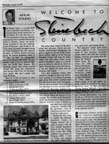 |
 |
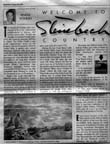 |
 |
 Painting of John Steinbeck and
his dog
|
 Photo of the Steinbeck house
|
 |
The Salinas Valley is a wonder filled land of adventure and folklore; otherwise known as the Salad Bowl of the Nation. Not only does this soil-rich area boast of crisp green lettuce and artichokes but of another kind of crop found in libraries around the globe. Novels cultivated by the late California pioneer of literature--John Steinbeck. He wrote stories of people's struggles during the Great Depression Era and captured the hearts of millions beyond that time period. My favorite Steinbeck classic is Of Mice and Men” the unforgettable tale of two transient field hands who desperately want to live in a place of their own and fulfill their dreams. Mr. Steinbeck penned other stories in prior decades that earned him international fame and the Noble Prize for Literature. Even people who don’t usually read enjoy his books.
Here is a list of some of John Steinbeck’s works:
The stories above made it on the silver screen and television. Check out your friendly neighborhood Block Busters and grab a nugget or two out of the Classic movie section. Stop by at the National Steinbeck Center’s gift shop for books, videos, and audio tapes. Costco carries some of Steinbeck’s videos at a nominal price or surfing the internet can also be an option. Renting them at the local library is the best method for those who are keeping a tight budget.
Like other prominent writers, John Steinbeck struggled at first in the 1920’s, never quitting on his dream of spinning tales of the field workers and their hard lives. He lived what he wrote. He had passion for what he created in his novels for the underdogs of society and spoke plainly how these poor creatures were mistreated by others because of greed. This did not make Mr. Steinbeck popular with Salinas during the heydays of his writings. The muckety-mucks burned his books near the location of what is now the National Steinbeck Center in downtown and called him a traitor and communist. Decades later the agricultural center of California hails him a hero. Local boy makes good.
During the first week in August, the National Steinbeck Center in Salinas kicked off a series of parties with the 21st annual Steinbeck festival for the Pulitzer Prize writer. His 100th birthday is coming up in February 2002. I went on Friday and stepped into John's world of history, agriculture, and human drama.
The impressive exhibit spans seven themed galleries of Mr. Steinbeck’s works in three buildings combined. People interact with each one, touching, hearing, watching, and reading about the stories the beloved author wrote. Because I'm wild about California history and agriculture, I camped out Steinbeck’s world most of the day. It's so easy to lose track of time there. There's plenty to do and explore for hours. Pretty much I glued my eyeballs to the screening of the classic Of Mice and Men” that starred Burgess Meredith. I love how they designed the lettuce boxcar from “Grapes of Wrath” as if it were an actual train carrying fresh produce. You could feel the icy cold from the crates of frozen lettuce. Huge books, colorful displays of shanty towns, creative sets, and thrilling musical score await adults and kids alike. It would be a crime not to visit this artistically pleasing museum.
Good-hearted volunteers ran the festival, I noticed how patient they were with people and not one of them was rude in speech or deed. The festival had a pleasant feel to it; a cozy, relaxing atmosphere. Professionals to retired folks from all walks of life came. The festival started with a reading out of the newly published children's book, “The Gift of Imagination: John Steinbeck’s childhood.” The following lectures were from Stanford on Mr. Steinbeck’s brief stint at the university and the other given by Dr. Gladstein about how teachers played an important role in the author's life.
Not all sessions were lectures. The festival showed three half-hour television segments based on Steinbeck’s book “Pastors of Heaven.” They made these back in 1954 and were about the citizenry living in the countryside known as the Pastors of Heaven. Each storyline had a compelling plot carried by an undercurrent of conflict and the human spirit. The whimsical characters delighted me; they didn't resort to fancy special effects and gobs of violence to get a point across. They simply used excellent storytelling techniques and decent acting. Something missing in Hollywood today!
Docents Barbara Paris and her assistant Ruth Muldoon took 15 of us on a walking tour of John Steinbeck’s stomping grounds. I loved this part of the festival the most; I get to talk with everybody while drinking in the sights and sounds of downtown Salinas. We stopped at John's birthplace on 132 Central Avenue where Barbara shared about his home life. Whenever she would stop and do this, Ruth would pass around a large glossy of what the building looked like back in those days. She carried a stack of them for us to see at the appropriate times during the tour. It was a treat for us; it added a neat element to the whole thing. Their friendly smiles and warm tones made it so much fun. The Oldtown Walking tours are on Saturdays at 2pm until the end of the summer, for $10 per person. Please call the National Steinbeck Center for reservations (831) 775-4720.
The Steinbeck’s home once considered to be in the fashionable neighborhood of Salinas still remains there today. Despite the changes of Central Avenue since 1935, the Victorian structure still has its charm. The Valley Guild, a non profit organization, keeps up the property and serves gourmet lunch to visitors daily. A spunky lady named Rosemary Guidotti, who gives tours inside the fully restored house, told us that John's sister Beth used to eat at the restaurant when she alive. She sat at a table by the large Bay window overlooking the street, however most people didn't recognized her. Rosemary Guidotti’s stories were such a kick! I loved talking to her. She commutes from Soledad to work at the Steinbeck house on Thursdays. There's also a gift shop that features the works of Steinbeck, knickknacks, and other trinkets. It's best to get reservations for lunch so that you can hear the capricious anecdotes of the docents there while dining on the home grown produce of Salinas Valley. The organization has 150 volunteers to run the lovely home and are there to serve you. Call (831) 424-2735.
During the tour, I met Betty Little and Randy Baily from Sacramento who happened to find out about the Steinbeck festival from the Sacramento Bee newspaper. Randy needed a break from his dairy job and went with Betty, despite the fact he never read any of Steinbeck’s novels. He prefers hard-boiled detective stories instead. Betty loves “Grapes of Wrath” that she read years ago. They both enjoyed the festival and the walking tour. A couple from Santa Rosa who didn't want their names in print heard about the festival through a Salinas paper. They also had a lady named Ann from England and a couple from the east coast. It's not uncommon for people from other countries to visit the multimedia exhibit of literature, history, and art.
Bus tours into different parts of the Salinas Valley gave folks a chance to experience what the characters of John Steinbeck’s novels went through:
These were just a few examples where the author played or worked. For those of you who missed out on this year's festival, don’t worry. Salinas will continue to whoop it up with a year-long celebration of the writer's 100th birthday (February 27, 2002) and will wrap it up next August with the 22nd Steinbeck Festival.
Expect more lectures on the writings, history of the Salinas Valley, the politics of the time, bus tours, art exhibits, book signings by noted specialists of Steinbeck literature, and writing workshops throughout the year. The Steinbeck house and restaurant will host the Special Centennial Sunday brunches for $25 bucks a person. The Wayward Bus will take the curious all over Steinbeck country in February for a fee. Interested? Contact them at (831) 775-4721.
The Western Stage theater company adapted Steinbeck’s story, “Tortilla Flat” which premiered on August 3rd and will through to September 2nd. They have a reputation for successfully sticking to close to his writings and doing a bang-up job. You don’t want to miss this one. For group rates call (831) 759-6012 or for individual tickets try the box office at (831) 755-6816. For those who prefer the internet, go to their web site www.westernstage.com.
The National Steinbeck center’s year-round three-building exhibit is open to the public from 10am to 5pm daily for a reasonable price. Adults pay $7.95, senior citizens & students $6.95, teens $5.95, and kids (6-12 years) get inside for $3.95. I went there three times already. The center’s gift shop, books, interactive exhibits, movies, friendly service, and interesting art galleries make this an enjoyable package for the whole family.
The agricultural heritage of the Salinas Valley is full of sweat, toil, and sacrifice by hard working people of the land. Remember them. That is the essence of what John Steinbeck’s stories say. If he were alive today, he would agree with me.
 |
 |
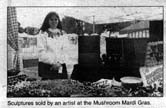 Sculptures sold by an artist at the Mushroom Mardi Gras |
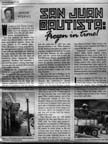 |
 |
 |
 Felipe's restaurant on 3rd street
|
 Horse drawn wagon downtown
|
 "Early days in San Juan Bautista"
|
Welcome to San Benito County! As I promised you in my last story, we’ll be stepping across county lines into our next destination: San Juan Bautista.
San Juan Bautista, the historic city hidden from Silicon Valley's mad rush to build multi-million empires, allures the weary pilgrim to it's ancient gates. What's the secret to it being unspoiled by the encroachment of high tech civilization? Come with me and found out. Walking the wide streets of San Juan Bautista transports me back into the days of Franciscan friars, Spaniards, native Americans, Banditos, and cowpokes. I can smell the polenta cooking from huge cast iron pots and smell the fresh manure of the soldier's horses.
Thanks to the Franciscan priest, Fermin de Lasuen and other Spanish settlers, he chose the ideal spot for the 15th mission at the foot of the Gavilan Mountains. Thus Mission San Juan Bautista (Spanish for St. John the Baptist) entered the world in 1797. The town grew in popularity with the mission as the centerpiece of their society. As a result more people came to settle down over the years and in 1869 San Juan Bautista became a city. When Southern Pacific Railroad broached the subject of creating a southern terminal for its trains to San Juan Bautista, the idea seemed great until the citizens had to shell out $50,000 bucks. People rejected the offer which forced the railroad to look elsewhere for greener pastures. Some guy named Col. Hollister accepted the bid for the railway company to build the train station on his ranch 7 miles east of San Juan Bautista.
The town lost out to Hollister as the hub of San Benito County in 1874. There are folks who are very glad this happened because the community's growth stopped. I think this may be one of the reasons why San Juan Bautista is pretty much left in a timeless state to this day. And such a wonderful place to escape to when one is sick of the frenzied pace of the San Francisco Bay Area. Don’t you agree? Why would someone want to live in Sunnyvale instead of San Juan Bautista? Okay, so a lot of the high tech jobs are there but if someone wants peace and quiet after a hard day's work, then taking refuge in the beloved “town” makes perfect sense. Here’s an example of someone who fell in love with the country charm of the area:
Paul Bunyon (not his real name) moved to the San Juan Bautista area in 1988 with his folks and eventually bought his own property in 1992 just outside the popular town on highway 129. He wanted to avoid living in the city (northern San Jose) where he works to settle down in the sticks. Paul bought his home for under $200,000 dollars at the time which was unheard of in the huge urban sprawls of the north. The reoccurring theme of South Valley living is the real estate is less expensive here than in most of the Bay Area.
Location! Location! Location!” That's often heard among many. Nothing can be closer to the truth. As I drove on highway 156 West through the gorgeous South Valley countryside; rolling golden hills, azure skies, garlic fields, eucalyptus trees, open roads as far as the eye can see, greeted me. How can anyone not want to live here? San Juan Bautista nestled in the foothills lay ahead amongst the rustic backdrop.
If you're heading on 101 South the town is 3 miles to the west between Gilroy and Salinas. Take 156 West or 120 to go directly there. Carmel and Monterey are half an hour away, however San Francisco is a bit farther out (about 97 miles). Within the South Valley area the smaller cities are ten or less minutes away from each other.
Once in downtown San Juan Bautista, gentle breezes swirled around me as I stepped out of my car. The weather is perfect here with an average temperature of 74 degrees during the summer and the average 64 degrees in the winter. It can get hot over here and also be colder than 64 in the wintertime; it just depends on the weather conditions. However on this particular day in June, a heat wave hit the South Valley but the cool air from the Monterey Bay made the outdoors bearable.
Floral scents from gardens in full bloom delighted my senses and the rural currents that swept across the age-old streets carried me away into another world from long ago. It's like walking into a television western from the 50’s whenever I pass through the town, gazing at the antique shops, Mom & Pop's Saloon, Bear Flag Gallery, Pricilla’s Special Stuff, Dona Ester’s Mexican Restaurant, Alexander's Bowie Bakery, the stately Masonic Hall, the picturesque Glad Tidings Church, and Juan De Anza Adobe house.
The food served in San Juan Bautista is fantastic from the great tasting Salvadoran treats of Felipe's Restaurant on 3rd Street, the scrumptious pickles from the local German deli, yummy sweets at The Candy Depot, and delicious meals for the family served by Mission Burger & Coffee Roasting Company. Dona Esther’s Mexican restaurant is popular among the tourists and locals for authentic south-of-the-border cuisine. There's a whole lot more to discover in this wonderful town than I already covered. I advise you to sample their eateries on your own; make a day of it and have fun.
The artists in the area display their workmanship in galleries all over town. For example, the Bear Flag Gallery features California artists’ creations with antiques which puts a unique twist for the exhibition. Galeria Tonantzin shows works by women artists via art, cards, and jewelry in a contemporary style on 3rd Street. If you'd like to meet the artist in the studio then Studio 808 on Washington Street will be the ticket for you. Please call ahead of time for appointments--(831) 623-2964. For those who love the theater, El Teatro Campesino’s production “Rositas Jalapeno Kitchen,” will be at The Teatro Playhouse on July 13th -August 5th. Show times are Thursday to Saturday at 8pm and Sunday at 5pm. For tickets call (831) 623-2444.
The Plaza History Association has many flocking to the Old mission where volunteers dressed in 19th Century costumes educate the public on the way people lived in the 1800’s on the first Saturday of the month. Between 12pm and 4pm on that “living history day” you may find mountain men camping on the expansive lawn adjacent to the mission, the town blacksmith at the local shop, and others garbed in old western attire mingling with the tourists in the Plaza or at San Juan Bautista State Historic Park. Activities include, candle making, spinning, dancing, loom weaving, and anything else to teach people the rich heritage of the Old Mission San Juan Bautista. All this neat stuff for $1 dollar for adults and kids 16 or under get in free. What a deal! Martha Gonzalez who works for the association is available to answer more questions on their attractions, please call (831-623-4881 to reach her.
San Juan Bautista Chamber of Commerce offers several events for the city. The 38th Annual Antique & Collectible Flea Market on August 5th will have 200 vendors selling their wares and the 24th Annual Arts & Crafts Show held on the streets features a couple of hundred vendors amazing the masses with their hand-crafted items. For more information on other chamber events please call them at (831) 623-4666.
Exploring the historical abundance of San Juan Bautista was a hoot! Now it's time to head east to Hollister. See you there!
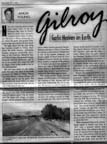 |
 |
 |
 Highway 101 through Gilroy at 5:00 (rush hour) Two cars! |
 Garlic fields |
Name one thing that draws people from major cities of the San Francisco Bay Area to Gilroy? Hint: It’s small, white, and packs a massive punch. Okay, so everyone who lives in Gilroy knows that it's our friend the garlic that attracts thousands to their beloved city all year round.
All right, that’s not the only thing that beckons people to Gilroy. How about the mild climate, affordable housing, gorgeous countryside, proximity to San Francisco, Monterey Bay, and Silicon Valley jobs, peaceful neighborhoods, thriving businesses, and so on. It’s no wonder why many have left the bigger cities of the north to live in this rural paradise.
But you must admit, it's the robust garlic that pops into most of our heads whenever we think of Gilroy. Kirsten Carr from Gilroy's Visitors Bureau told me people want to see the garlic. The world knows the South Valley city takes their precious crops so seriously and yet with tender-hearted affection.
Have you noticed whenever you drive into Gilroy on a sunny day, the first thing that greets your nose is the tantalizing scent of crushed garlic? The air stimulates the mind with images of plates heaped with the pungent bulbs in creamy sauces. When I used to attend the Weight-Watchers meetings in Gilroy, I remember the alluring aroma and how it tempted me to run to the nearest restaurant and devour a plate of Sour-Cream & Chive Potatoes. I loved to roll the car windows down, gulping in lungfuls of the garlicky air. It sounds silly but it was euphoric! I believe the folks at Weight-Watchers in Gilroy deserve a gold medal for losing weight while living in “gourmet heaven.” I marvel at their steely determination.
The world-renown Garlic Festival attracts 120,000 people a year during the last weekend of July. Anyone who has gone there understands why it's so special. The festival is a culinary legend with a smorgasbord of garlic masterpieces for the taste buds. The entertainment is just as eclectic as the food. Rows of artisans selling their exotic wares astound the fiercest art critic; the children’s section is mega-fun for adults too. The whole experience borders on the sacred for us garlic lovers. The Visitors Bureau’s Kirsten Carr said 475 inquirers came into the office or called, asking about the garlic festival and Bonfante Gardens (Gilroy's newest attraction). Unfortunately, all lodgings in Gilroy are already booked up for the garlic festival. People may want to check with hotels in the surrounding cities if they aren’t able to find a place to sleep in Gilroy for that weekend.
Kirsten also mentioned about a man from Winnipeg, Canada who named his restaurant “Gilroy” in honor of the beloved city. He knows the world-class reputation of the garlic grown there and offers savory dishes with the cherished cloves on his menu.
Here’s another example of how the citizenry of Gilroy are nuts about the bulbous plant. The members of the Theater Angels Art League is hosting a 5K run or walk and 10K run to benefit the city’s cultural arts building fund. The 3rd annual Reek Run will be on Sunday, July 15th. The overall winners will receive garlic wreaths, so get them running shoes and come out and join many others in this scenic race at Gavilan College. I’ll be there too! For registration details please contact President Shirley McGee at (408) 846-9191.
What catapulted Gilroy to its international status? It started way back in 1817 with a pioneer named Juan Bautista Gilroy who settled in the area. Later he married Clara Ortega, heiress to the San Ysidro Ranch. After the gold rush in 1850, more people made their homes in the fertile valley and took up raising cattle and growing grain. No big surprise that the town became the hay and grain capital of California a decade later. It turned out Gilroy, which grew into a city, reached agricultural fame four more times:
1. Tobacco Capital of the United States (1870’s).
2. Diary & Cheese Capital of California (1870’s).
3. Prune capital during the 1920’s.
4. Garlic King of the World!
Italians brought garlic to the region at the turn-of-the-century and so did Japanese farmers after World War I. The idea of the garlic caught on like wildfire. The rest is history!
It’s perfectly understandable why people move to Gilroy for the beautiful surroundings and country charm. Fruit stands, garlic stores, and wineries greet drivers as they pass through the city on highway 101. There's so much fun stuff to choose from for the avid garlic fan at Garlic World located on Monterey highway near U.S. 101 and the garlic festival store in downtown Gilroy.
Another attraction of Gilroy is their prime outlet shopping center which sells top-notch items like designer clothing, shoes, housewares, travel gear, fine crafts, etc., from 150 factory stores. The popular In & Out Burger near the outlets, serves the public with amazing efficiency at great prices for a tasty meal under 5 bucks. It’s an excellent way to quench the appetite from all that shopping!
Between Morgan Hill and Gilroy 12 local wineries dot the rustic landscape, blessing people all over with a myriad of vintage wines. They offer tours and wine tasting by appointment, please contact Gilroy's Visitors Bureau for arrangements at (408) 842-6436.
There are so many facets to Gilroy besides the diversified cuisine. The newest pride and joy of the city is Bonfante Gardens off Hecker Pass (Highway 152 West). This 75 acre botanical extravaganza defies imagination. It’s the first theme park focused on horticulture with a mid-20th Century agricultural California flair. Don’t let that fool you, it's not just a bunch of fancy gardens for people to gawk at. This park has 40 rides, including a restored 1927 Illions Carousel and a genuine rollercoaster. It’s a perfect place to visit for the whole family. For more information contact Bonfante Gardens at (408) 840-7100.
Another eye-popping wonder on Hecker Pass is Goldsmith Seed’s “Field of Dreams” flower gardens. This is a sight to behold! The gorgeous bright flowers are from thousands of experimental breeds. Everyone is welcome to stop by for a free tour; it's best to call Goldsmith Seeds, Inc. for arrangements. Their phone is (408) 847-7333.
Pristine parks in the area make the ultimate escape for those of us who live in major cities. Mount Madonna appeals to campers all-year-round with its breathtaking views of the Santa Clara Valley and Monterey Bay. I love to run on the trails through the forest whenever I can. What a delightful treat! Let’s not forget Henry Coe State Park to the east of Gilroy. Not only is it Northern California's largest park but It’s also one of my favorite places to hike or run the lovely, wide spaces. Within the city limits is Christmas Hill park which is the official site of the Garlic Festival and is open everyday for outdoor enthusiasts. For those lovebirds; these wonderful recreational spots make the ideal backdrop for a romantic picnic as well.
Golf legend Johnny Miller designed Eagle Ridge Golf club’s 18 hole championship course with pastoral appeal in mind. The course entices golfers with spectacular views of mountain ranges, creeks, and eagles soaring above. PGA instructors, a restaurant, golf shop, and other amenities make up a splendid package for residents, corporations, and visitors alike.
Twenty years ago, Mary Hagins of Gilroy, left her job at a local newspaper and started her own publication in her garage. Today, Mary’s weekly paper can be found in people’s mailboxes on Wednesdays throughout Santa Clara and San Benito counties. A stretch of Monterey Street in downtown Gilroy is known by the locals as “The Miracle Mile,” where the publication got its name.
Friendly people like Kirsten and Pam from the Visitors Bureau, and Shirley McGee from TAAL make Gilroy a lively place to visit and a marvelous place to settle down with family. It was a pleasure talking to them about Northern California's “Little town with a big flavor.”
Next week we cross into San Benito County. San Juan Bautista awaits you!
 |
 |
 |